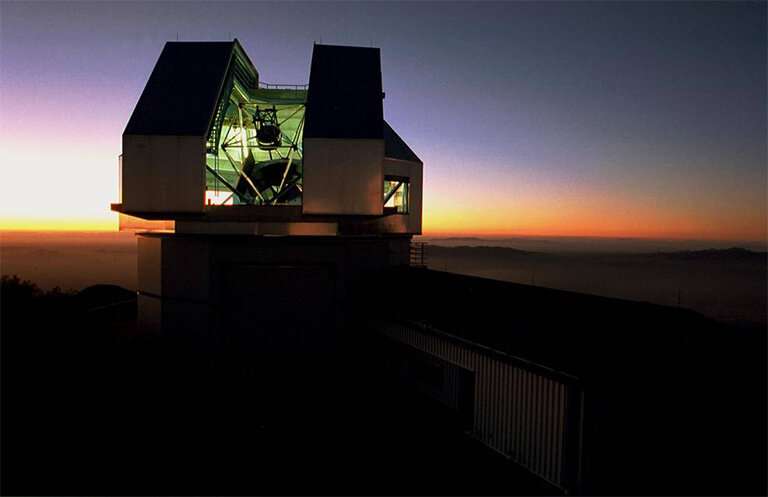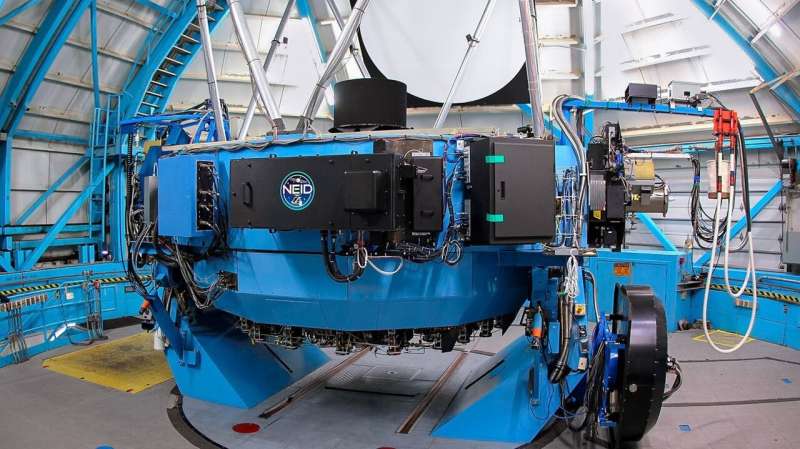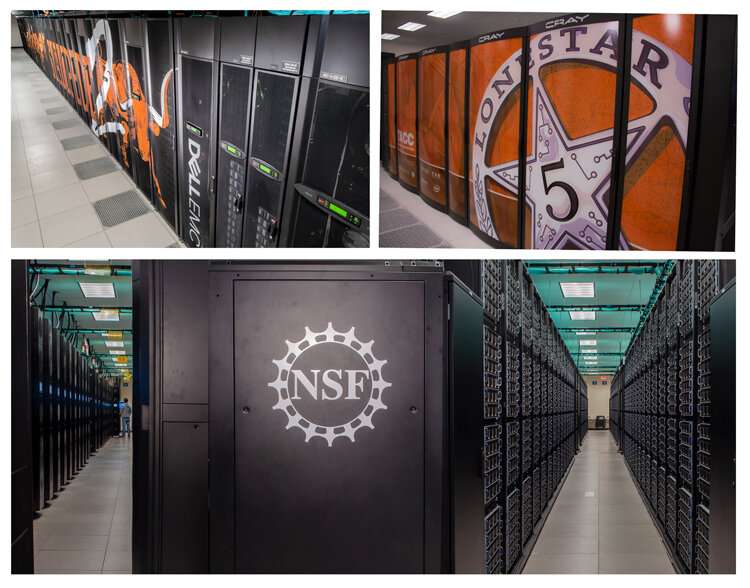Hunting for alien planets with a new solar telescope

Thousands of alien worlds are known to orbit stars beyond our solar system. And many more worlds, possibly harboring life, lie waiting to be discovered. A new astronomical instrument called NEID, the NN-explore Exoplanet Investigations with Doppler spectroscopy, has come online in 2021 to help scientists hunt for new alien worlds.
The Texas Advanced Computing Center (TACC) is assisting the effort with supercomputer time and expertise in NEID's scientific search for new worlds.
The name "NEID" derives from the word meaning "to see" in the native language of the Tohono O'odham, on whose land Kitt Peak National Observatory is located. NEID is a spectrograph attached to the WIYN 3.5m telescope at the observatory in Arizona.
"We're proud that NEID is available to the worldwide astronomical community for exoplanet discovery and characterization," said Jason Wright, professor of astronomy and astrophysics at Penn State and NEID project scientist. "I can't wait to see the results we and our colleagues around the world will produce over the next few years from discovering new, rocky planets, to measuring the compositions of exoplanetary atmospheres, to measuring the shapes and orientations of planetary orbits, to characterization of the physical processes of these planets' host stars."
NEID does this by breaking down visible light from distant stars into its component wavelengths with a spectrograph, like a simple prism does but with additional parts such as diffraction gratings. Optical fibers feed starlight to the spectrograph, where light signatures are recorded by a detector.
NEID takes advantage of the Doppler effect. The light data collected can be used to detect minute shifts in wavelength over time, which like the pitch change of an approaching or receding train horn, indicates movement. The wobbly movement evidenced by light wavelength shifts indicates a gravitational tug on a host star by potentially undiscovered planets.

Each night, NEID collects about 150 gigabytes of light data that is sent to Caltech and then to TACC for processing. The center developed a fully automated computational pipeline for NEID data.
"The pipeline copies data to us from Caltech via the Globus research data management network," said Mike Packard of TACC's Cloud & Interactive Computing (CIC) group. "A data analysis then runs on TACC's Frontera system. It uses the Tapis API to store metadata. Then it sends the data back to Caltech for scientists to analyze."
The NASA Exoplanet Science Institute coordinates the data processing and makes the data available through its community archive.
The Tapis project, funded by the National Science Foundation, is a collaboration of TACC and the ITS-Cyberinfrastructure group at the University of Hawaii. Tapis provides a hosted, unified web-based API for securely managing computational workloads across institutions.
"NEID is the first of hopefully many collaborations with the NASA Jet Propulsion Laboratory (JPL) and other institutions where automated data analysis pipelines run with no human-in-the-loop," said Joe Stubbs, who leads TACC's CIC group and is the lead technical person at TACC on the NEID project. Stubbs is also a principal investigator on the Tapis project.
"Tapis Pipelines, a new project that has grown out of this collaboration, generalizes the concepts developed for NEID so that other projects can automate distributed data analysis on TACC's supercomputers in a secure and reliable way with minimal human supervision," Stubbs said.

The NEID pipeline has used several thousand compute hours on TACC's Lonestar5, Frontera, and Stampede2 supercomputers. Furthermore, TACC supports NEID with virtual machines, hardware nodes on the Rodeo cloud system, and network connectivity to Globus Online.
Built as part of a joint NSF and NASA program, NEID's mission is to enable some of the highest precision measurements currently possible, as well as to attempt to chart a path to the discovery of terrestrial planets around other stars.
The seething convection on the surface of stars, threaded by invisible lines of magnetic force and marred by ever changing active regions and "starspots" can pose a substantial challenge to NEID's measurements. This stellar activity is one of the major impediments to enabling the detection of rocky planets like our own. For very small signals it is difficult to tell which are planets and which are just manifestations of stellar activity.
However, the researchers added, there is one star for which we know the answer, because we know exactly how many planets orbit it—our sun. In addition to observing stars during the night, NEID will also look at the sun through a special smaller solar telescope that the team has developed.
"Thanks to the NEID solar telescope funded by the Heising-Simons Foundation, NEID won't sit idle during the day," said Eric Ford, professor of astronomy and astrophysics and director of Penn State's Center for Exoplanets and Habitable Worlds. "Instead, it will carry out a second mission, collecting a unique dataset that will enhance the ability of machine learning algorithms to recognize the signals of low-mass planets during the nighttime."
The NEID instrument is funded by the joint NASA/NSF Exoplanet Observation Research Program, NN-EXPLORE, managed by JPL, a division of Caltech in Pasadena, California. The 3.5-meter WIYN Telescope is a partnership among Indiana University, the University of Wisconsin, Penn State, the University of Missouri-Columbia, Purdue University, NOIRLab and NASA.
The NEID team includes members at Penn State, JPL, NOIRLab, NASA Goddard Space Flight Center, the University of Pennsylvania, the University of Arizona, the University of Wisconsin, the National Institute of Standards and Technology / University of Colorado, Boulder (NIST/CU), the Space Telescope Science Institute, Macquarie University, Princeton University and Carleton College, and the University of California, Irvine.
More information: Jeffrey W. Percival et al, The NEID precision radial velocity spectrometer: port adapter overview, requirements, and test plan, Ground-based and Airborne Instrumentation for Astronomy VII (2018). DOI: 10.1117/12.2312209
Provided by Texas Advanced Computing Center




















